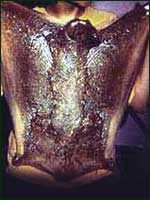Kagwang
Cynocephalus volans
The common names of animals are sometimes descriptive and revealing—the purple-throated sunbird, for example, or even the rusty-crowned tree babbler. At other times, they are no help at all. A case in point is the animal sometimes called, in English, the Philippine flying lemur (Cynocephalus volans), a species widespread on the southern islands that once made up the Ice-Age island of Greater Mindanao. These creatures are not lemurs, and they do not fly. They are, however, quite attractive, with beautiful dark eyes, a broad muzzle with a soft nose, soft wooly fur spotted with white, and an odd fold of skin between the front and hind limbs. The large fold of skin allows them to glide (not fly) between trees for distances up to 135 meters, much like North American and Asian flyingsquirrels.
Flying lemurs are, in all likelihood, related to bats, but they are so distantly related to bats or anything else that they and their one close relative (in Malaysia and Indonesia) are placed in their own Order by biologists. All monkeys, true lemurs, apes and humans (253 species) make up one Order; all squirrels, beavers, rats, and their relatives (2,166 species) make up another, and so on; the two species of flying lemur have an Order all to themselves. Giving such unusual animals distinctive names seems only right, and so we call them by their specific local names: kagwang in the Philippines and colugo in continental Asia.
Kagwang are nocturnal, gliding out from a tangle of vines and leaves or a hollow tree each evening a the sun sets. They eat only tender young leaves, but almost never eat more than a few from a single tree;they seem intent on sampling a little of everything in the forest. Unlike the great majority of unique Philippine mammals, the kagwang actually prefers disturbed rain forest over old-growth, probably because many trees that grow in such places have sweeter leaves, without the tannins and alkaloid compounds that make old-growth plant leaves bitter. As a result, kagwang are more widespread, and their populations more stable, than many other Philippine mammals.
Original URL: http://archive.fieldmuseum.org/vanishing_treasures/V_Kagwang.htm

